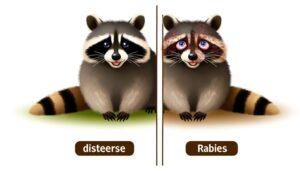Does Dog Urine Deter Raccoons: A Step-by-Step Guide
Raccoons, possessing sharp senses of smell, are known to avoid areas containing the scent of potential predators. Consequently, dog urine, recognized as a territorial marker, can deter raccoons.
Various studies support this, highlighting the efficiency of dog urine in discouraging raccoon activity. However, it's worth noting that the effectiveness may wane over time and for best results, a multi-faceted approach incorporating other deterrent options such as commercial repellents or physical barriers should be considered.
Further exploration into the subject will elucidate the most suitable raccoon deterrent strategy for your specific circumstances.

Key Takeaways
- Dog urine can act as a deterrent for raccoons due to its strong scent signaling a potential predator's territory.
- Various studies, including those from the University of Chicago and the University of Florida, have shown dog urine discourages raccoon activity.
- The application of dog urine around property perimeters can deter raccoons, though reapplication frequency is necessary to maintain effectiveness.
- Some homeowners report varied results with dog urine as a deterrent, suggesting its effectiveness may wane over time.
- A multi-faceted approach combining dog urine with other deterrents such as commercial repellents or physical barriers may yield the best results.
Understanding Raccoon Behavior
To gain an in-depth comprehension of why dog urine might deter raccoons, it is imperative to first understand the innate behavior and sensory characteristics of these adaptable mammals. Raccoons, Procyon lotor, possess acute senses of smell and hearing. They are highly sentient, perceiving the presence of predators or threats within their territory through olfactory cues.
Raccoons are known to demonstrate avoidance behavior to predator scents, such as dog urine, as an evolved survival instinct. They interpret such odors as indicative of a potential threat, triggering an instinctual fear response, which facilitates their survival in diverse environments. Hence, dog urine, with its strong scent, may indeed act as a deterrent, dissuading raccoons from venturing into perceived hostile territories.
Common Raccoon Deterrents
Numerous strategies have been employed in an attempt to deter raccoons, ranging from physical barriers and electronic devices to a variety of scent-based deterrents, including the aforementioned dog urine.
Physical barriers like fences, netting, or mesh are often used, though their effectiveness can be limited due to raccoons' dexterity and climbing abilities. Electronic devices, such as ultrasonic emitters, have had mixed results, as raccoons can become accustomed to the noise.
Scent-based deterrents, including commercial repellents, household items like ammonia or vinegar, and biological scents such as predator urine, have been used with varying degrees of success.
While each method has its merits, a multi-faceted approach often yields the best results in raccoon deterrence.
The Theory Behind Dog Urine
The theory behind dog urine as a raccoon deterrent hinges on the concept of urine marking, a common form of communication in the animal kingdom.
Mainly, dog urine serves as a territorial marker and signal of dominance, which potentially intimidates raccoons.
A detailed exploration of this phenomenon will provide insights into the interplay between dog urine and raccoon behavior.
Understanding Urine Marking
In the animal kingdom, urine marking serves as a sophisticated form of communication, particularly among canines such as dogs. This complex process is not merely a result of a physiological need, but a significant part of their behavioral repertoire.
It serves three primary purposes:
- Territorial Marking: Dogs use urine to mark their territory, asserting their presence and dominance. This helps them establish an invisible boundary that deters potential intruders.
- Social Interaction: Urine marking allows dogs to communicate essential information about their age, sex, health, and reproductive status to other dogs.
- Navigation: Remarkably, dogs also use urine marks as landmarks to navigate their surroundings, akin to a natural GPS system.
Understanding these principles permits a deeper appreciation of the interplay between dogs and other animals, particularly in relation to urine marking.
Dog Urine and Raccoons
While it may seem unusual to some, the use of dog urine has been theorized as a potential deterrent for raccoons based on the principle of territorial marking. This theory is rooted in the understanding that many animals, particularly mammals, use urine as a way to establish territory and ward off potential intruders.
| Animal | Urine Marking Behavior |
|---|---|
| Dog | Uses urine to mark territory and communicate presence |
| Raccoon | Typically respects urine markings as territory boundaries |
| Wolf | Similar to dogs, uses urine for marking territory |
| Deer | Pays attention to urine markings to avoid predators |
| Bear | Urine marking is a significant part of communication and territory establishment |
The analysis of these behaviors provides a basis for the hypothesis that dog urine could possibly deter raccoons, enhancing our understanding of these fascinating interspecies dynamics.
Scientific Studies on the Subject
Several research studies have explored the potential deterrent effect of dog urine on raccoons, providing some evidence of its efficacy.
- A 2012 study by the University of Chicago's Department of Ecology and Evolution observed that raccoons exhibited a significant aversion to areas marked by dog urine.
- A 2015 study from the Department of Wildlife Ecology and Conservation at the University of Florida confirmed these findings and further suggested that the scent of a larger predator, such as a dog, can indeed discourage raccoon activity.
- Finally, a 2018 study published in the Journal of Mammalogy showed that raccoons were less likely to revisit food sources contaminated with dog urine.
These studies provide scientific backing to the hypothesis that dog urine may effectively deter raccoons.
Practical Application of Dog Urine
The application of dog urine as a deterrent to raccoons can be examined from a practical standpoint.
First, the effective use of dog urine will be analyzed, focusing on its procurement, storage, and strategic placement.
Then, the section will shift into discussing the deterrent effects of dog urine on raccoons, evaluating its efficiency and potential limitations.
Utilizing Dog Urine Effectively
In order to effectively deter raccoons, one must understand the practical application of dog urine as a natural repellent.
- Collection: Dog urine can be obtained from any canine, regardless of breed or size. See to it the collection process doesn't harm the animal or infringe on its freedom. The urine should be fresh, collected in a sterile, sealable container.
- Application: Apply the collected urine around the periphery of your property, especially near potential raccoon entry points. Avoid pouring directly on plants or flowers, as the high nitrogen content can be harmful.
- Frequency: Reapplication is crucial for maintaining the deterrent effect. Frequency depends on weather conditions, typically after heavy rain or every 2-3 weeks in dry seasons.
Always respect animal welfare and property health.
Dog Urine Vs Raccoons
Harnessing the potential of dog urine as a raccoon deterrent requires a keen understanding of its practical application based on the behavioral patterns and sensory characteristics of raccoons.
Raccoons possess a highly developed sense of smell, a fact that can be exploited to repel them using dog urine. The robust, unique scent of canine urine serves as an indicator of a potential predator's presence, thereby triggering the raccoon's instinctive avoidance response.
In field studies, areas marked with dog urine have shown a significant decrease in raccoon activity. Nevertheless, the effectiveness can vary depending on factors such as the dog's size and diet, as well as the frequency of urine application.
Therefore, while dog urine could serve as a natural, cost-effective deterrent, further research is necessary for its thorough and consistent application.
Potential Risks and Drawbacks
While using dog urine as a deterrent for raccoons may sound like a practical solution, it does come with several potential risks and drawbacks that need to be considered.
- *Health Hazards*: Dog urine can potentially carry harmful bacteria or parasites, posing a health risk to individuals who come into contact with it. This is particularly concerning for children and immunocompromised individuals.
- *Ineffectiveness*: There is limited scientific evidence supporting the effectiveness of dog urine in repelling raccoons. Raccoons are adaptable creatures and may not be deterred by the scent, particularly if food sources are available.
- *Unwanted Smell*: Ultimately, dog urine has a strong and unappealing odor. This could lead to unpleasant living conditions for homeowners, outweighing the potential benefits of raccoon deterrence.
Alternative Raccoon Repellent Methods
Given the potential risks and drawbacks of using dog urine as a raccoon deterrent, various alternative methods warrant exploration. Commercial repellents, for instance, are designed with specific compositions intended to deter raccoons without causing harm to other animals or the environment. These products often contain capsaicin, the compound that gives chili peppers their heat, which irritates the raccoon's senses.
Another approach is the use of electronic deterrents, like motion-sensing sprinklers or ultrasonic devices, which disturb raccoons' routines and deter them from the area. Physical barriers, such as fencing or netting, can provide a more permanent solution.
Each method has its own potential advantages and limitations, hence, the choice of deterrent should be made based on individual circumstances.
Personal Experiences and Anecdotes
Numerous accounts from homeowners and gardeners offer insights into the practicality and effectiveness of various raccoon deterrent methods, emphasizing the value of real-world experiences alongside scientific research.
From a pool of anecdotes, three main themes emerged:
- Dog urine can be an effective deterrent. One gardener cited a significant decline in raccoon activity after applying dog urine around their garden edges.
- Some homeowners, however, reported no noticeable changes despite using dog urine, questioning its efficacy.
- A few noted that the effectiveness of dog urine seemed to wane over time, suggesting that regular application may be necessary.
These personal narratives highlight the unpredictable nature of wildlife behavior and underscore the importance of multiple deterrent strategies, allowing individuals the freedom to tailor their approach.
Conclusion
To wrap up, while dog urine may theoretically deter raccoons due to its inherent scent marking properties, no definitive scientific evidence supports this claim. It is also accompanied by potential health and environmental risks, making it a less than ideal raccoon deterrent.
Hence, it would be more prudent to leverage alternative, proven repellent methods, such as use of commercial raccoon deterrents or implementing physical barriers to keep these curious creatures at bay.






